| Article ID | Journal | Published Year | Pages | File Type |
|---|---|---|---|---|
| 5769723 | Scientia Horticulturae | 2017 | 9 Pages |
â¢Differences were found among the 20 Spanish pomegranate cultivars.â¢Cultivars with soft seeds and high sweetness are optimal for fresh consumption.â¢Cultivars with an intense red color and hard seed are optimal for juice processing.â¢Pomegranate cultivars can be considered as a source of fiber and natural antioxidants.
Spain is the main European pomegranate producer. Depending on the characteristics and composition, pomegranate fruits may be intended for fresh consumption, industrial processing or medicinal purposes. Therefore, is important to evaluate the variability of different pomegranate cultivars to gain more knowledge about the potential of these fruits. In terms of physicochemical and functional parameters in pomegranate arils, the highest values and concentration were: crude fiber, 2.85% (BA1); potassium, 1.19Â g 100Â gâ1 dry weight (PTO5); total sugars, 15.9 and 15.5Â g 100Â mLâ1 (SM and VA1 respectively); total acids, 4.89Â g 100Â mLâ1 (SM); total polyphenol content, 1791Â mg GAE 100Â gâ1 dry weight (BBE1); ABTS, 4.24Â mmol Trolox kgâ1 fresh weight (MEC); DPPH, 7.74Â mmol Trolox kgâ1 fresh weight (MO6); seed hardness score, 7.0 (BA1 and BBE1), aril color, intensity 7.0 (WOND and SM) and sensorial score, 3.0 (ME12, MEM, MEC). Significant differences were found among pomegranate cultivars: soft seeds and high sweetness are optimal for fresh consumption; an intense red color and hard seed are optimal for juice processing; high total polyphenol content, antioxidant activity, crude fiber and minerals can be used as a functional food. Pomegranate cultivars can be considered as a source of fiber and natural antioxidants to develop functional foods.
